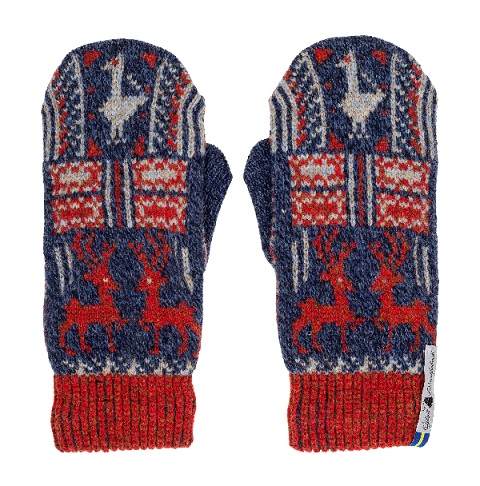Öjbro Vantfabrik Merino Wool Socks
scania marten knee sock
Scania Marten Merino Wool Knee Socks by Öjbro
A beautifully knit Merino Wool Knee sock in the Scania Marten design.
These socks have some stretch to them so the size ranges will overlap. These size translations are approximate but if you know your European shoe size, use that.
Small is marked as "34-37"
US Men's Shoe Size 4-8
or US Women's Shoe Size 5-7
Medium is marked as "38-41"
US Shoe Size 8-10
or US Women's Shoe Size 7-10
Large is marked as "42-45"
US Men's Shoe Size 10.5-12 or
US Women's Shoe Size 9-12
Some may want to size up for a wider fit in the calf.
[Fabric Content: 70% Merino Wool 25% Nylon 5% Spandex]
Scroll below to see larger image and the story behind the design.
$39.95
- 0.5 lb
- Available
- Ships within 4-8 business days

The Story behind the Pattern # Scania |
|
|
Scania or as we say Skåne is a region of Sweden that is often referred to as Sweden’s pantry. Skåne is Sweden’s most southerly region, mostly composed of
peninsulas. Skåne has a multi-faceted landscape of which around 70% is either farmland or pastureland. It became prominent in the 12th and 13th century as a centre for international
trade due to its rich herring fishing in Öresund, the produce of which was sold in Skanör and Falsterbo, where the so-called Skåne Market played an important role during the Middle
Ages. Skåne has 240 castles and stately homes, including Hovdala Castle, whose ancestors can be traced back to the start of the 16th century. The defences were extended some time in
the 17th century, among which the characteristic tower. The castle burned down in 1678 but its occupant, Jöns Mickelsson, rebuilt it. He became a nobleman and was given the name
Ehrenborg, and Hovdala was to remain in his family for nine generations. The castle is presently a national heritage. Märta Måås-Fjetterström’s workshop can be found in Båstad. Märta Måås (1873-1941) has been called the pioneer of Swedish textile art and still has a great influence on modern-day design. She was a qualified arts teacher and worked, among other places, at the Culture Museum in Lund and the Swedish Handicrafts Association in Malmö, and so started to draw weave designs early on. At the Baltic Exhibition held in Malmö in 1914, she was acknowledged by Ludvig Nobel, who acquired her knotted pile rug “Hjorthagen”. He encouraged her to open her own workshop in Båstad. Märta Måås-Fjetterström created more than 700 designs for rugs and woven fabrics and MMF AB has administrated her treasure trove of patterns since 1942. All items are hand-woven in wool and flax from her own dye works. A sketch with the inscription “be of good cheer” lay on her desk when she died on Easter Sunday in 1941, and so never came to be woven. Åse Öjbro, the designer and founder of Öjbro Mitten Factory, has created wearable art with mittens as the starting point. Åse also worked as an artist, making paintings for many years before deciding to express herself in wool. She has created this decorative mitten design with 2 red deer and Skåne’s emblematic goose at the top. A design with clear symbols on the upper-side of the mittens. The wrist ribbing has dual colouring associated with Skåne’s fertile soil. “I wanted to capture the proud spirit of Skåne in my interpretation symbolised by its stately red deer. Skåne, which is a rich region in many ways with industries such as Trelleborg, Tetra Pak och Perstorp. Kivik’s Cider Company, spettekakan (spit cake), svartsoppa (black soup) and gåsamiddag (goose lunch). I wanted to personally honour the gifted Märta Måås-Fjätterström and her fantastic work with my design Scania.” |
 We don’t know how long mittens have been knitted in Scandinavia, but fragments of mittens have been preserved from as far back as the 13th century. *These mittens are inspired by Märta Måås-Fjetterström and her life’s work. Skåne’s beautiful red deer and then coloured in traditional colours. Öjbro Mitten Factory is passionate about keeping our various knitting traditions alive. |




